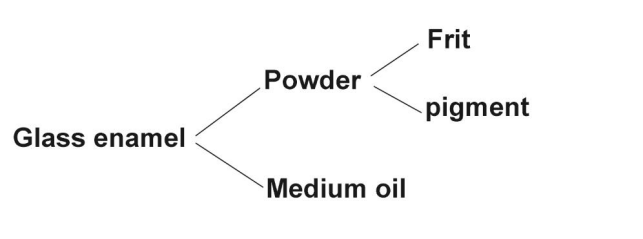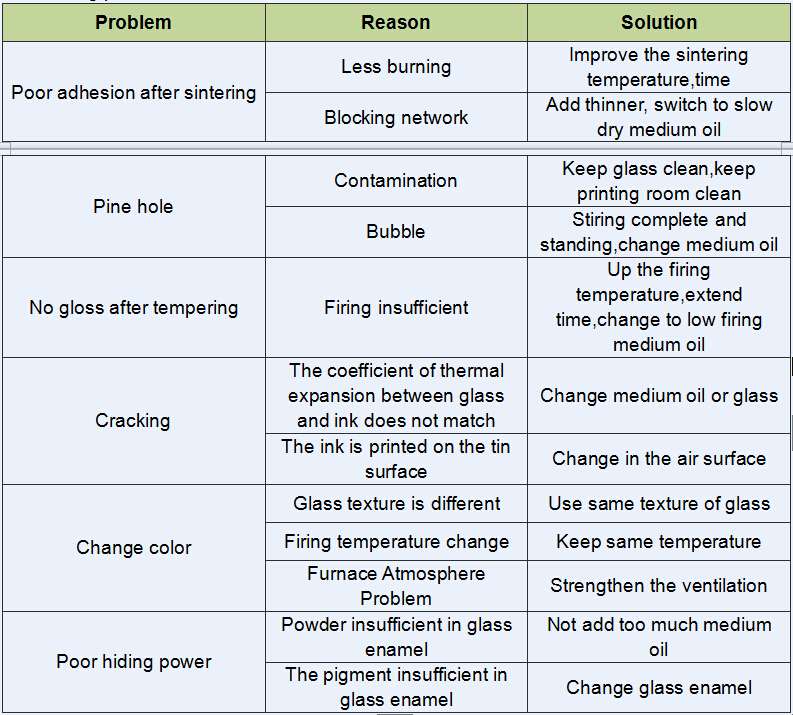1. Application
The main application of glass enamel is decorating tempered glass (architectural glass,home appliance glass,furniture glass) and auto glass .
2. Tempered glass enamel
Type: architectural glass;home appliance glass;furniture glass
Function:
decoration
conceal the frame of building, electronic component or for showing.
3. Auto glass enamel
Type: Front windshield glass enamel;Rear windshield glass enamel;Side winshield glass enamel and silver paste.
Function:
To prevent ultraviolet radiation through the glass
To prevent the glue used to bond the glass and car occur chemical change
Conceal some conductive lines
Decoration
4. Decorate glass ware
Type: cosmetic bottle,beverage bottle,wine bottle,tableware cup[
Function:
decoration
develop the new product
fix the label
5. The composition of glass enamel

1) The powder of glass enamel: Frit and Pigment
a.Frit: a mixture of silicon dioxide as a main component and melted at a high temperature
b.Function:
sintering performance,the combination of ink and glass
Wear resistance
Chemical resistance
Thermal expansion coefficient
Gloss
a.Pigment: A mixture of metal oxides that can be melted at high temperatures
b.Function:
Color
Hiding powder
2) Glass enamel: the powder of glass enamel ;medium oil
Frit: a mixture of silicon dioxide as a main component and melted at a high temperature
Function:
sintering performance,the combination of ink and glass
3) Medium oil: A mixture of organic compounds
Function: To provide printing performance on glass
6. The method of application
Spraying ; Roller printing ; Screen printing ; Curtain printing
1) Spraying
Advantage:
a. suitable small scale production
b. Can achieve a good printing thickness
c. Ink and water miscible, water cleaning equipment
d. Suitable for all sizes and shapes of glass
Disadvantage:
a. Excessive spraying produces contamination
b. Excessive spraying results in loss
c. Low production efficiency (hand spray)
d. Labor intensity (hand spray)
e. Can not print pattern
2) Roller printing
Advantage:
a. High production efficiency
b. Can achieve high printing thickness
c. Less contamination of the glass edge
d. High yield
e. Suitable for all sizes of glass
f. Clean
Disadvantage:
a. Not suitable for small-scale production
b. Can not print pattern
3) Screen printing
Advantage:
a. Suitable for printing patterns and overprint
b. Do not pollute the glass edges
c. High yield
d. Less ink consumption
e. High production efficiency
Disadvantage:
a. Screen, making pattern costs
b. Low printing thickness
c. Not suitable for small-scale production
4) Curtain printing
Advantage:
a. High production efficiency
b. A high printing thickness is obtained
c. Ink and water miscible, water cleaning equipment
d. Suitable for all sizes and shapes of glass
e. Clean
Disadvantage:
a. Glass edge contamination
b. There is a certain waste rate
c. Not suitable for small-scale production
d. Can not print pattern
7. Printing
A. Printing instructions
1) room temperature (20 ~ 23 ℃) storage ink to prevent precipitation;
2) by adding medium oil, the use of low-speed mixer to adjust the viscosity;
3) to maintain the standard temperature (21 ℃) measured viscosity;
4) diluted, stirring the ink (suspension) standing 30min to eliminate the bubbles generated during mixing;
5) The glass must be clean and dry, keep the same with the printing room temperature;
6) to ensure that the glass is always printed on the same side (tin surface or non-tin surface) to avoid color;
7) measuring the thickness of the printing to ensure that the thickness of the same, the thickness of the change may lead to changes in color;
8) immediately after printing drying to prevent dust adhesion;
9) For overprint, the glass must be returned to room temperature, and then the second color printing.
B. Printing problems

8. Drying
1) The method of drying: Infrared drying, UV curing (for automotive glass), hot India (flat cup, bottle)
2) Purpose: A solid print layer was obtained before sintering and stored again.
3) Parameters: wet film thickness, ink evaporation rate, drying speed, drying temperature.
Recommendation: Immediately dry after printing to avoid sticking dust
4) Meidum oil: solvents (such as pine oil, terpineol), polymers, additives (such as surfactants, flow agents, thixotropic agents)
Note: For screen printing with varnish, can provide oil or water-based varnish
Copyright ©2008 Qingdao Caitian Industrial Materials Co., Ltd.
Powered by : HiCheng